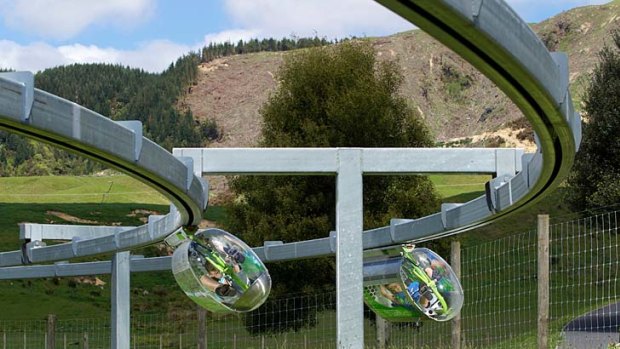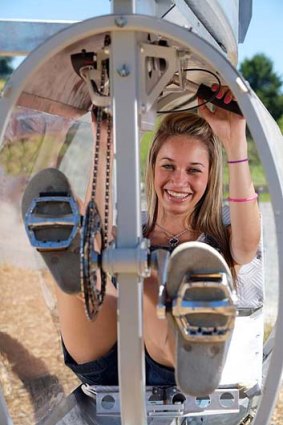This was published 13 years ago
Shweeb ride, bro: is this the future of public transport?

Due to the lack of resistance, it's easy to hits speeds of up to 50km/h on board a Shweeb.
Craig Platt test drives a form of transport Google has backed to the tune of $1 million.
Locked into a small, transparent tube hanging from a rail, reclining, with my feet placed on a couple of pedals in front of me, two things are going through my mind. One, is this really the future of public transport? And two, am I going to beat this sucker?
I'm in Rotorua, New Zealand, at Agroventures, an adventure park that takes some of New Zealand's more extreme activities (bungy jumping, jet boating, 'freefalling' above a giant fan) and gathers them in one place.

Passengers recline and reportedly use 50 per cent less energy than on a bicycle travelling at the same speed.
My small tube, known as a Shweeb, is the least extreme of the activities on offer here, but it is the most interesting.
The Shweeb, best described as a one-person, pedal-powered inverted monorail, is the invention of Australian Geoff Barnett. Developed in Melbourne over six years, the Shweeb track came to Rotorua in 2007.
It may not sound like the future of public transport, as posed above, but it was interesting enough to search-engine giant Google to put $1 million toward the idea, beating out 150,000 competitors in the company's Project 10^100, a global competition aiming at supporting change around the world and including a category for driving innovation in public transport.
As for my second thought above, that's directed towards my opponent on the rail. Agroventures has two Shweeb rails that run parallel (crossing over at one point to even out the inside curve advantage) so you can race against a friend as you reach speeds of up to 50km/h.
After getting comfortable in our Shweebs, we wait for the lights to change to green, Grand Prix-style, and then we're go, go go!
As we're on rails, there's no need to steer, we just have to concentrate on pedalling and hitting the right gears. We tear along the rail and I feel a bit like I'm on a giant version of the slot car racing set I had as a kid.
Even though our Shweeb capsules are transparent, I find it difficult to keep track of where my opponent is (though I realise later that, as there's no need to steer, there was no reason why I couldn't have been looking out to the side to keep track, instead of facing forward and looking at my own feet).
As there's very little resistance, the Shweebs can get up to high speeds quite quickly and without having to pedal too hard. About 40km/h can be reached without too much effort, though in non-racing environments it's expected that commuters would amble along at 20 to 25 km/h. Barnett claims that aerodynamic design of the vehicles would mean Shweebers would expend only half the energy of road cyclists for the same speed.
On our third and final lap, I make a rookie mistake – shifting down a gear when I should have been shifting up. It's enough for my momentum to drop and my opponent becomes level. As we cross the finish line, we ease off the pedals. There's so much momentum we actually complete a fourth lap barely touching the pedals.
In the end, the scoreboard says I've lost the race by 0.1 seconds. Damn.
So could this be the future of public transport? It's hard to see it as more than a fun adventure ride after a brief test, but the inventor is serious about the concept. The official Shweeb website offers a wealth of detail about how the system would work in practice.
Of course, with governments around Australia still struggling to invest in their current crumbling public transport systems, a major investment in something like the Schweeb seems a bit pie-in-the-sky (even though the Schweeb website promises a transit Schweeb will be built for public use with its location announced “soon”).
In the meantime, the Schweeb will remain a bit of fun for thrillseekers in New Zealand.
The writer travelled with assistance from Destination Rotorua and Air New Zealand.
A race on the Agroventures Shweeb (three laps of the 200-metre track) costs $NZ39 for adults and $NZ29 for children. For full details see http://www.agroventures.co.nz
For more information on Shweeb visit http://shweeb.com
Rotorua to the extreme
While Queenstown is known as New Zealand's capital of extreme activities, Rotorua is no slouch in this area either. Among the other activities we try at Agroventures is 'The Swoop' – much like a bungy jump, but with a more swinging motion. It's great fun, after the initial second or two of freefall, which is terrifying.
Outside the adventure park there are several other activities worth pursuing for the adrenaline junkie.
Just outside Rotorua is the seven-metre Tutea Falls waterfall – the highest commercially rafted waterfall in the world. Anyone can go join a guided rafting trip along the Kaituna River and over the falls without any previous experience.
River Rats run a variety of whitewater rafting trips in the area including the Grade 5-rated Kaituna trip. A full safety briefing occurs before the trip, including what to do if the raft flips over after going over Tutea Falls (it happens occasionally – but without the risk, where's the fun?). See http://www.riverrats.co.nz for details.
Rotorua is also the original home of Zorbing, the somewhat ludicrous activity of placing oneself inside a giant inflatable ball and rolling down a hill. There are both wet and dry versions of this experience, though the wet version is more fun. The dry version sees you strapped into place inside the ball, turning end over end in a nausea-inducing trip. In the wet version, a small amount of warm water is placed inside the ball with you, leaving you free to slip and slide up and down the ball's interior in an experience akin to being inside a washing machine. See http://www.zorb.com for details.
More information on Rotoura
Sign up for the Traveller Deals newsletter
Get exclusive travel deals delivered straight to your inbox. Sign up now.